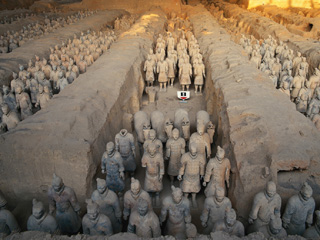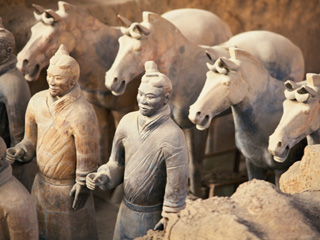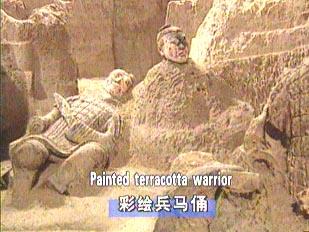 |
|
| The Terracotta Warriors and Horses of Qin |
| CCTV.COM 2003-07-27 13:07:36 |
|
 Without the discovery of the terracotta warriors and horses, Xiyang Village in Lintong County of Shaanxi Province would have never attracted the attention of the world as it does today. Without the discovery of the terracotta warriors and horses, Xiyang Village in Lintong County of Shaanxi Province would have never attracted the attention of the world as it does today.
This dramatic discovery happened in the spring of 1974. “We were digging a well. When we reached a depth of four metres, we found a clay man in the pit. Its head, body, arms and legs had been broken. We took them out of the pit and handed them to the authorities,” said Villagers who discovered the terracotta warriors and horses.
Archaeologists reacted to the villagers' discovery immediately. They didn't expect that they would start a major archaeological discovery in China in the 20th century.
Today when people enter the Museum of Terracotta Warriors and Horses Guarding the Mausoleum of the First Emperor of Qin, they are stunned by the grand view. But what they see is only a small part of the outer area of the mausoleum.
More than 2,000 years ago, Sima Qian, the most prominent historian in ancient China, described the grandeur of the Mausoleum of the First Emperor of Qin in his great work Records of the Historian.
It was a mythical and boundless underground world. In the burial chamber, magnificent palace buildings were put up, the universe, the starry sky and the geographical features were imitated, and a large quantity of mercury was filled in to represent rivers, lakes and seas.
 In 221 B.C., the First Emperor of Qin unified China. Construction of his mausoleum began in the same year. More than 700,000 labourers worked on the site. The 38-year project was completed after the death of the emperor. In 221 B.C., the First Emperor of Qin unified China. Construction of his mausoleum began in the same year. More than 700,000 labourers worked on the site. The 38-year project was completed after the death of the emperor.
The underground martial array was almost a reproduction of the massive army of the empire of Qin. It achieved the unification of China for the First Emperor of Qin. Then it undertook the new mission to defend the unified empire and its founder.
But the powerful empire collapsed three years after the death of the First Emperor of Qin. The insurgent troops stormed into Xianyang, the capital of the empire.
The magnificent palaces and halls built during the reign of the First Emperor of Qin were burnt down in a big fire. His mausoleum was not spared.
The excavation and repair of terracotta warriors and horses has been going on for more than 20 years. Not long ago, a new discovery caught widespread attention again.
This is a unique painted terracotta warrior. A lot of remaining paint has been found from the body.
 The new discovery has confirmed the archaeologists' opinion that all the terracotta warriors and horses were painted, but almost all the paint peeled off with the elapse of time. The new discovery has confirmed the archaeologists' opinion that all the terracotta warriors and horses were painted, but almost all the paint peeled off with the elapse of time.
The excavation of the Mausoleum of the First Emperor of Qin has not been carried out on a full scale. Nobody can predict how many mystical discoveries are in store for us.
In 1987, UNESCO included the Terracotta Warriors and Horses of Qin in the World Heritage List.
|
|
Editor: Liu Baoyin CCTV.com
|
|
|
|
|
|
 |









